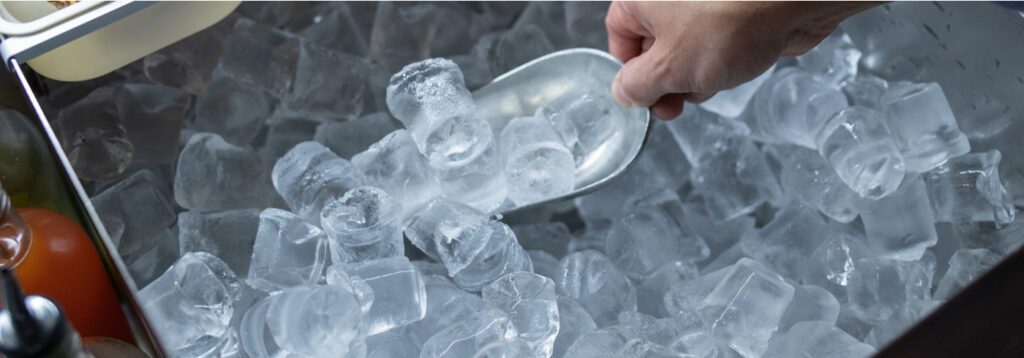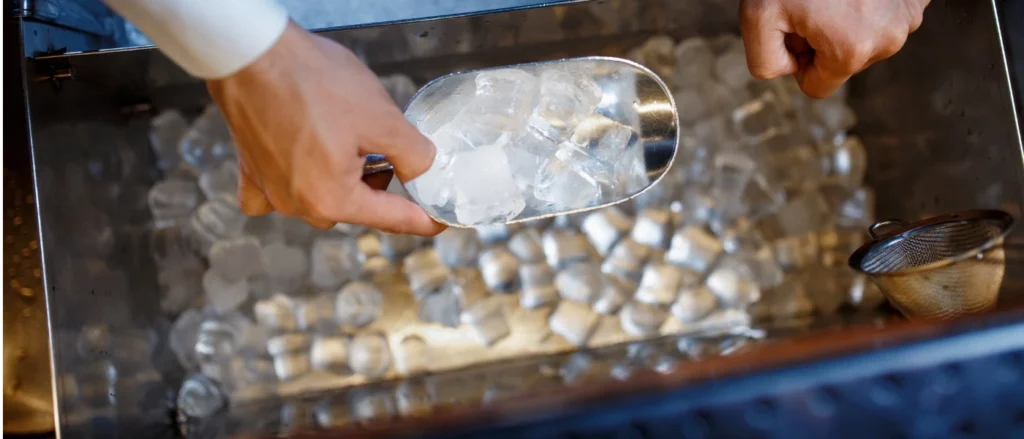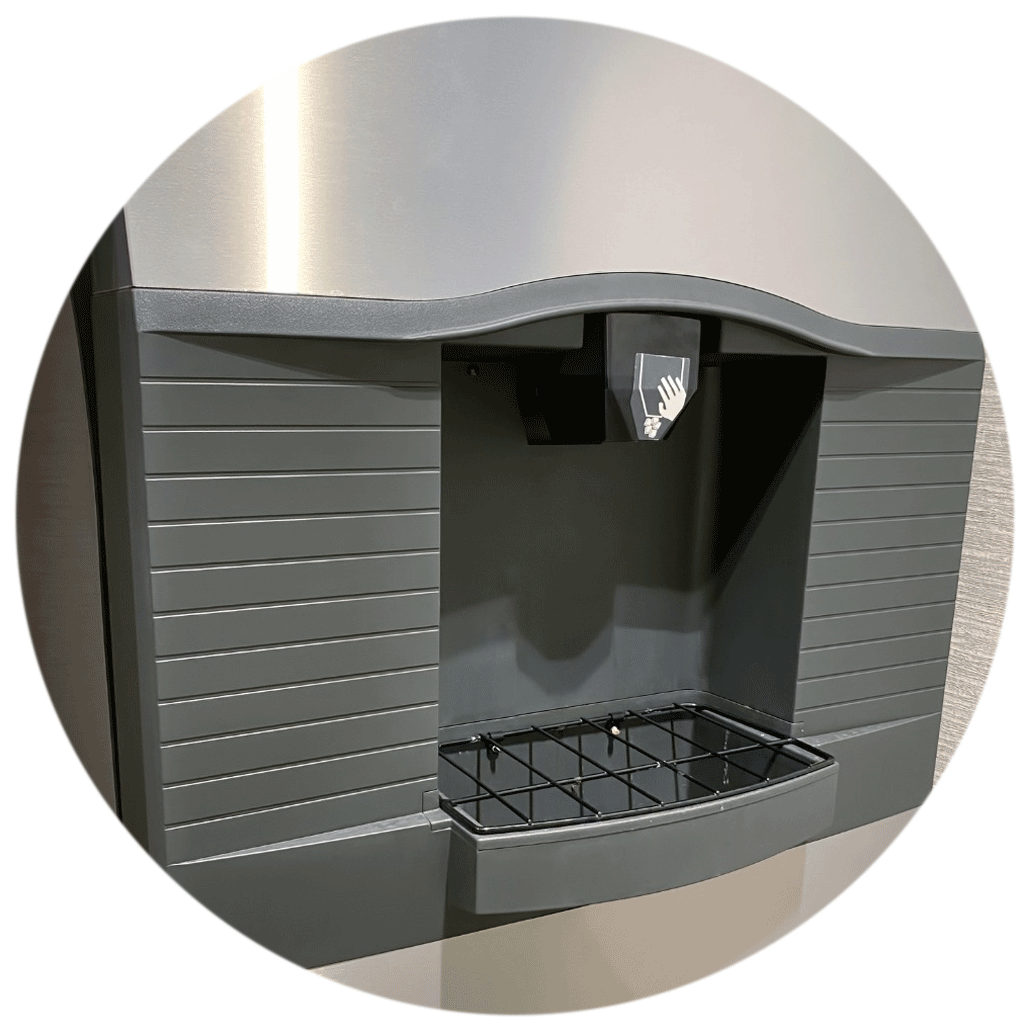
The use and importance of ice have evolved dramatically over the years – from a luxury item during the turn of the 20th century to a common necessity found in homes and restaurants around the world. For commercial kitchens in restaurants and bars, an efficient and effective ice maker is a key ingredient for serving drinks and keeping food items cold.
Although the Food & Drug Administration (FDA) does not directly regulate and inspect the making of ice in foodservice establishments, they are subject to regulation by state and local authorities. The FDA Food Code, after which most state and local food regulations are modeled, contains provisions related to the safe and sanitary production and handling of ice, including measures that protect against contamination from food or drink. It is the responsibility of restaurants and bars to make sure they are following all local guidelines and laws for safe ice use.
Simple Steps for Safety

Given how often ice is used in today’s busy restaurant and bar businesses, it is critical to maintain and keep the ice maker clean, sanitized and operating smoothly. Surface cleaning should be done daily to remove debris, with a deeper cleaning process performed several times per year. If a kitchen’s ice machine is producing less ice than normal, partially-formed, or cloudy cubes, or if ice smells or tastes different, it is probably an indication that it needs cleaning or maintenance. As such, there are important steps to take to keep an ice maker in good order and customers safe.
- Stock Up on Cleaning Supplies: Taking inventory of proper cleaning supplies is always a good first step before beginning a cleaning project. There are a few key items to make sure to have on hand, including:
- Personal protective equipment: Cleaners should consider wearing gloves, masks, aprons, and potentially goggles or eye protection, to keep them protected from cleaning solutions.
- Cleaning cloths or wipes: A clean towel or multi-surface cleaning wipes should be used to remove dirt and debris from the machine.
- Cleaning/sanitizing solutions: The machine also needs to be deep cleaned using sanitizing wipes to help eliminate common bacteria and pathogens. A descaler solution may also be needed if using an automatic cleaning mode for the lines.
- Water filter: A replacement filter should be kept on hand during cleaning in case a new one needs to be installed.

- Remove Ice for Cleaning: The timing of the cleaning should be coordinated around the machine’s peak use, such as after closing time or on a closed day. While each brand of commercial ice makers may be slightly different, they each will have a reservoir or bin where the ice is stored after it is made. All loose ice must be removed from the bin for a thorough cleaning. Any ice or frost that has accumulated should also be scraped and removed. Once free of ice and buildup, the bin should be sanitized.
- Activate Ice Maker Cleaning Cycle: Some ice makers have a “clean mode” that can be set to clean the lines and internal unit. It may require the use of a descaler cleaning solution, which is most likely a vinegar and water mixture. The service manual should be checked to determine instructions and the recommended time for the cleaning cycle (20-45 minutes).
- Remove Ice for Cleaning: The timing of the cleaning should be coordinated around the machine’s peak use, such as after closing time or on a closed day. While each brand of commercial ice makers may be slightly different, they each will have a reservoir or bin where the ice is stored after it is made. All loose ice must be removed from the bin for a thorough cleaning. Any ice or frost that has accumulated should also be scraped and removed. Once free of ice and buildup, the bin should be sanitized.
- Activate Ice Maker Cleaning Cycle: Some ice makers have a “clean mode” that can be set to clean the lines and internal unit. It may require the use of a descaler cleaning solution, which is most likely a vinegar and water mixture. The service manual should be checked to determine instructions and the recommended time for the cleaning cycle (20-45 minutes).
- Remove Parts and Components for Cleaning: An ice machine’s manual should be consulted to see what parts or components need to be removed to be cleaned or replaced. The machine’s power should be turned off and disconnected throughout the process to reduce the risk of any hazards. Certain specialty ice machines, such as ice flakes and nugget ice machines, may have unique parts that will need to be cleaned as well.
- Clean and Sanitize Components and Surfaces: Thoroughly cleaning and sanitizing all the parts and surfaces of the machine is essential to eliminate bacteria and pathogens, such as listeria. In addition, any limescale, calcium carbonate, mold, rust, or hard water buildup must also be scrubbed and removed. Any food contact surfaces of the machine should also be sanitized to prevent the risk of cross-contamination. Soaking any parts that may have stubborn debris and then rinsing all components with clean water may also be necessary.
- Reassemble and Replace Needed Parts: After cleaning all components and giving them a thorough rinse, they need to be completely dried. Follow the service manual to re-assemble the machine and its components and replace any old or used parts that regularly need to be cycled out, such as the water filter. The interior and the reservoir should be given a final wipe using a dry towel to remove any moisture and prevent the ice from sticking together.
- Run, Discard, and Ready: Once running again, the machine will need to produce one full bin of ice and be discarded to make sure no lingering debris or unwanted flavors are in the contents. Once cleared, normal operations can resume, and the machine is ready to make fresh ice for serving. The base and exterior of the ice machine should be cleaned daily and kept free of water around the machine to avoid slippery floors.
Maintaining the Commercial Ice Maker
Like any large kitchen appliance, a commercial ice machine should be cleaned and maintained daily, and deep cleaned and sanitized regularly. This will keep the machine working at optimal efficiency, help reduce the spread of dangerous germs and pathogens and extend the life of the machine. All cleaning should be done according to the local health department and manufacturer's guidelines.
Cleaning an ice machine is a simple but important component to maintaining a safe kitchen environment for staff and customers, as well as ensuring drinks are served icy cold and taste great!

